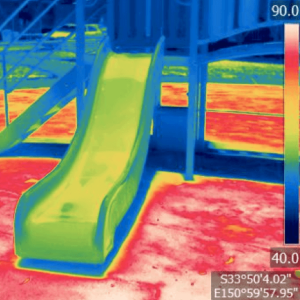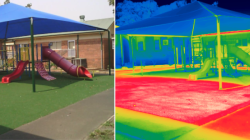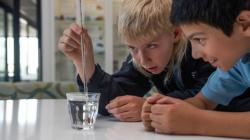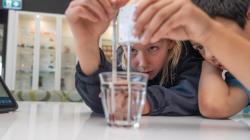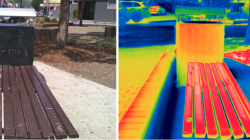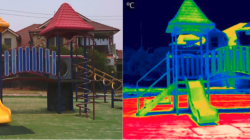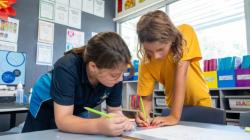'Scorching swings and slides' is one of our new teaching sequences for AC V9
- On the 'Sequence overview' tab you'll find all the lessons in this sequence and curriculum alignment.
- The 'Our design decisions' tab shows how key scientific ideas develop over the sequence, and shows how the sequence addresses curriculum achievement standards.
- The 'Preparing for this sequence' tab guides you through important information and considerations for this sequence.
- Have you taught this sequence? Use the Feedback button to let us know how it went!
Launch
Lesson 1 • What happens to playground equipment when it’s hot?
Students are introduced to the core concept being explored—heat—through the context of playground equipment on a sunny day.
Inquire
Lesson 2 • What’s hot?
Students participate in hands-on experiences to identify and categorise sources of heat.
Lesson 3 • How does heat move?
Students participate in hands-on experiences to explore heat moving from one object to another.
Lesson 4 • Which ground is best for a playground?
Students plan and conduct an investigation to compare the conductivity of different materials, and determine which type of ground surface might be most suitable for use in a playground.
Lesson 5 • Which playground building material gets the hottest?
Students plan and conduct a further investigation to compare the conductivity of different materials, and determine the suitability of specific materials to playground design.
Lesson 6 • How effective is shade at reducing heat transfer?
Students plan and conduct an investigation to find out if putting an object in the shade impacts the transfer of heat.
Act
Lesson 7 • Designing a playground for the heat
Students apply their learning by designing a playground or piece of playground equipment with the aim of reducing heat transfer.
The Australian Academy of Science supports and encourages broad use of its material. Unless indicated below, copyright material available on this website is licensed under a Creative Commons Attribution-NonCommercial-ShareAlike 4.0 International (CC BY-NC-SA 4.0) licence.
Curriculum and syllabus alignment
Achievement standards
Students identify sources of heat energy and examples of heat transfer and explain changes in the temperature of objects. They describe how people use data to develop explanations. They identify solutions that use scientific explanations.
Students pose questions to explore patterns and relationships and make predictions based on observations. They use scaffolds to plan safe investigations and fair tests. They use familiar classroom instruments to make measurements. They organise data and information using provided scaffolds and identify patterns and relationships. They compare their findings with those of others, explain how they kept their investigation fair, identify further questions and draw conclusions. They communicate ideas and findings for an identified purpose, including using scientific vocabulary when appropriate.
Australian Curriculum V9 alignment
Science as a human endeavour
Science understanding
Identify sources of heat energy and examine how temperature changes when heat energy is transferred from one object to another
Science inquiry
Pose questions to explore observed patterns and relationships and make predictions based on observations
Use provided scaffolds to plan and conduct investigations to answer questions or test predictions, including identifying the elements of fair tests, and considering the safe use of materials and equipment
Follow procedures to make and record observations, including making formal measurements using familiar scaled instruments and using digital tools as appropriate
Construct and use representations, including tables, simple column graphs and visual or physical models, to organise data and information, show simple relationships and identify patterns
Compare findings with those of others, consider if investigations were fair, identify questions for further investigation and draw conclusions
Write and create texts to communicate findings and ideas for identified purposes and audiences, using scientific vocabulary and digital tools as appropriate
Australian curriculum content links
| Science understanding core concept: Energy, in the form of heat, can be transferred. |
| Sub-strand | Content descriptor | AC code | Achievement Standard | How the sequence addresses this content |
| SHE: Use and influence of science | Consider how people use scientific explanations to meet a need or solve a problem. | AC9S3H02 | Identify solutions that use scientific explanations. | Design an outdoor play area or piece of equipment that will still be safe to play in/on during the hottest days of summer. (Lesson 7) |
| SHE: Nature and development of science | Explain how people use data to develop scientific explanations. | ACS9S301 | Describe how people use data to develop explanations. | Use scientific explanations, supported by data, to describe the materials chosen, and how they will minimise the transfer of heat. (Lesson 7) |
| SU: Physical sciences | Identify sources of heat energy and examine how temperature changes when heat energy is transferred from one object to another. | AC9S3U03 | Identify sources of heat energy and examples of heat transfer and explain changes in the temperature of objects. | Find sources of heat in the school/home. (Lesson 2) Investigate and represent heat transfer using standard scientific conventions. (Lessons 2, 3, and 7) Explain how temperature changes as a result of heat transfer. (Lesson 6) |
| SI: Questioning and predicting | Pose questions to explore observed patterns and relationships and make predictions based on observations. | AC9S3I01 | Pose questions to explore patterns and relationships and make predictions based on observations. | Pose investigable questions, such as: ‘What happens to the temperature of a surface when it comes into contact with a heat source?’ in order to identify patterns. (Lessons 4, 5, and 6) |
| SI: Planning and conducting | Use provided scaffolds to plan and conduct investigations to answer questions or test predictions, including identifying the elements of fair tests, and considering the safe use of materials and equipment. | AC9S3I02 | Use scaffolds to plan safe investigations and fair tests. | Collaboratively design a table to support the collection of numerical data. (Lesson 2, 3) |
| SI: Planning and Conducting | Follow procedures to make and record observations, including making formal measurements using familiar scaled instruments and using digital tools as appropriate. | AC9S3I03 | Use familiar classroom instruments to make measurements. | Explore how to use equipment such as thermometers and taking accurate readings with guidance. (Lessons 3, 4, 5, and 6) |
| SI: Processing, modelling and analysing | Construct and use representations, including tables, simple column graphs and visual or physical models, to organise data and information, show simple relationships and identify patterns. | AC9S3I04 | Organise data and information using provided scaffolds and identify patterns and relationships. | Use diagrammatic representation to model heat transfer. (Lessons 2, 3 and 7) Record and represent data showing temperature change. (Lessons 3, 4, 5 and 6) |
| SI: Evaluating | Compare findings with those of others, consider if investigations were fair, identify questions for further investigation and draw conclusions. | AC9S3I05 | Compare their findings with those of others, explain how they kept their investigation fair, identify further questions and draw conclusions. | Compare findings of investigations, and identify further questions based on observations, differences, or new ideas. Discuss factors that make investigations fair and evaluating the fairness of an investigation. Draw conclusions based on their own and others’ findings. (Lessons, 2, 3, 4, 5, 6 and 7) |
| SI: Communicating | Write and create texts to communicate findings and ideas for identified purposes and audiences, using scientific vocabulary and digital tools as appropriate. | AC9S3I06 | Communicate ideas and findings for an identified purpose, including using scientific vocabulary when appropriate. | Present play area/equipment solutions using explanations appropriate for audience and identifying the appropriate actions for that audience. e.g. Writing to local council about modifying existing playgrounds, presenting findings to the school’s parent association/principal encouraging the installation of new play equipment, creating a campaign to educate fellow students on ways to minimise exposure to excess heat when playing on sunny days. (Lesson 7) |
Science journals
Create a class science journal, either in hard-copy or digitally. You might:
- use/create a large scrap book or flip chart.
- use poster/butchers’ paper so learning can be displayed in sequence on the wall.
- use the accompanying PowerPoint as a digital record of learning.
- create a digital journal using your platform/ technology of choice.
- any combination of the above.
Plan for students’ creation of an individual science journal, either in hard-copy or digitally. They might:
- use an exercise book, scrap book or flip chart to record their thinking and gather resource sheets together.
- use a folder to store and collate resource sheets, diagrams, photographs etc.
- use a digital folder to store work samples, images and videos.
- any combination of the above.
See Using a science journal throughout inquiry for more detailed information on the importance of science journals.
Additional preparation
- Read through the teaching sequence.
- Note any adaptations you would like to make to suit your schools’ and students’ context.
- Source local examples of images and videos depicting outdoor playgrounds equipment that students are familiar with, and if possible a thermal image of the same playground taken on a hot day. Examples are provided in the sequence if you are unable to source local examples.
- Make a note of the ground coverings or surfaces that students might be able to measure the temperature of during the sequence.
- Decide if your students will be designing their playground, or if you would also like them to build a 3D prototype/model as well. If you decide to build prototypes/models, you might like to ask students to begin collecting materials that might be useful. Materials should be re-used and recyclable. Examples include boxes (tissue, cereal, shoe, etc.) and other cardboard products, foil and trays made out of foil, bottle tops and jar lids, skewers, paddle pop sticks, etc.
The materials required for each lesson are listed on the lesson's page. For the full sequence resource list, download the Preparing to teach this sequence document below.
